Field of the Cloth of Gold
(1520)
|
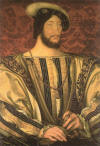
King Francois I of France
by
Jean Clouet
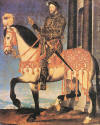
King Francois I of France
by
François Clouet |
In
the early 16th century the balance of power in Western Europe was a precarious
one; the major players being Francois I of France and Carlos V, Holy Roman
Emperor. Each monarch tried to build a set of alliances to swing the balance in
their favour. Into the mix came England, under
King Henry VIII of England.
Henry's chief
advisor, Thomas, Cardinal Wolsey, favoured an alliance with France.
Henry's
queen,
Catalina of Aragon, favoured the Empire (the Emperor
Carlos was her nephew). Yet
Henry and
Catalina's daughter
Mary was affianced to Francois's son, the
Dauphin.
Henry himself was undecided as to which alliance offered him the best chance of
personal and national gain. He played a waiting game in an attempt to stay on
good terms with both Carlos and Francois, hoping perhaps that no matter which
monarch gained the ascendancy, England would benefit.
In 1520
Henry was persuaded to forge an
alliance with France. A meeting was arranged between the two monarchs at a
location just outside Calais, a bit of unremarkable countryside between the
villages of Ardres and Guines.
Henry VIII, his wife,
Catalina of
Aragon,
and virtually the entire English court traveled across the English Channel for a
meeting with King Francois I of France, for the purpose of establishing a
political alliance. These two monarchs were rivals, both politically and
personally, and each prided himself on the splendour of his court.
|
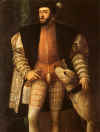
Carlos V,
Holy Roman Emperor
by Tiziano
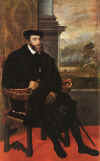
|
When
it was determined that the castles of both villages were in too great a state of
disrepair to house the courts, they camped in fields, Francois at Ardres and
Henry at Guines. Even the valley in
which the two kings met was artificially levelled so that neither of them would
have an unfair advantage over the other! This was no ordinary camping expedition; huge
pavilions were erected to serve as halls and chapels, and great silken tents
decorated with gems and cloth of gold. Each camp occupied about 2.5 acres (1 hectare) of
land, and included a large pavilion to serve as a great hall, another for a
large chapel, and numerous gilded tents to house the kings’ enormous retinues
(which numbered in the thousands at both camps). The silken tents were richly
decorated with cloth of gold and precious gems, as were the throngs of courtiers
and ladies in waiting. A temporary gilt fountain was built, with three separate
spouts for claret, spiced wine, and water. Some idea of the size of
Henrys following may be gathered from
the fact that in one month 2200 sheep and other viands in a similar proportion
were consumed. In the fields beyond the castle, tents to the number of 2800 were
erected for less distinguished visitors, and the whole scene was one of the
greatest animation. Ladies gorgeously clad, and knights, showing by their dress
and bearing their anxiety to revive the glories and the follies of the age of
chivalry, jostled mountebanks, mendicants and vendors of all kinds.
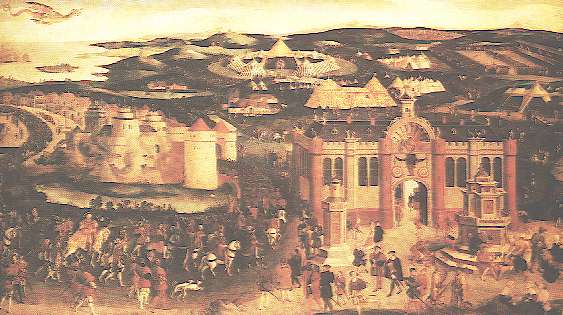
Field of the Cloth of Gold
Unknown
artist 1520
It
is this ostentatious display of wealth and power that earned the meeting-place
between Francois and
Henry the sobriquet "The Field of the Cloth of Gold". Journeying from Calais
Henry reached his headquarters at Guines the
4 Jun 1520. The
meeting lasted for three weeks (7 Jun - 24 Jun 1520), during which time each
court strove to outdo the other in offering splendid entertainments and making
grandiose gestures. Masterminded by the great
Cardinal Wolsey, each
king and Court strove to outshine the other. After
Cardinal Wolsey, with a
splendid train, had visited the French King, the kings first met at the Val Dor, midway between the
two camps, on 7 Jun. The subsequent meetings and entertainments were conducted
with much apparent cordiality, although "many persons present could not
understand each other". Feasts and jousts were held, including a tilt
between
Henry and Francois themselves. There were processions, masques,
balls, banquets, sporting events, and even fireworks.
Queen Catalina sat
beneath a canopy of estate entirely lined with pearls to watch her husband and
King Francois joust against one another. Each day the monarchs and their
entourages appeared in more sumptuous and elaborate costumes. The expense incurred by both monarchs was
enormous, and put tremendous strain on the finances of each country.
Henry was accompanied by 5,000 people and spent in excess
of £13,000 on the splendour of the occasion. Among those attendants were ten
chaplains, and one of them was John Taylor. The
King ordered each priest to be
clothed in damask and satin and each to be followed by his own attendants, not
exceeding ten persons and four horses. The English built a splendid pavilion,
a temporary palace of wood and canvas, with ‘windows upon windows upon windows’. The Flemish glazier
Galyon Hone created the windows. Fine malmsey and claret
flowed from two drinking fountains.
One morning, King Francois rose early and, without
telling any of his nobles, he rode quite alone to the English camp.
Henry was still in bed when
Francois came into his room and said, laughing, "My dear cousin, I
come to you of my own free will. I am now your prisoner".
Henry was very pleased to see that
Francois trusted him so much that he was not afraid to come quite alone like
this. He sprang out of bed and threw a chain of gold round the French King's
neck. In return Francois gave
Henry a beautiful bracelet, and then,
laughing and joking like a schoolboy, he insisted on helping
Henry to dress. He warmed his shirt,
helped him to tie and button his clothes, and then, mounting on his horse, rode
gayly home.
When he came near his castle he was met by some of his
nobles, who were anxiously looking for him. Francois laughingly told them
what he had been doing.
"Sire, I am very glad to see you back again..."
said one of them, "But let me tell you, master, you were a fool to do what
you have done. Ill luck be to him who advised you to do it."
"Well, that was nobody, the thought was all my own."
replied Francois.
After
Wolsey had said mass
the two sovereigns separated on the 24th. Yet for all the trouble they went to,
the results of the meeting were negligible. Though
Henry and Francois agreed in
principle to an alliance, it was just two weeks later that
Henry met with Carlos himself
in England. By the terms of this new treaty between England and the Empire, each
agreed to not sign any new treaties with France for two years, and the betrothal
of Mary to the Dauphin was
broken in favour of a new betrothal to Carlos himself. Two years later
King Henry declared war on
France, and his ally, the Emperor Carlos, did likewise soon afterward.
Nevertheless, by 1525, the betrothal between Mary and
Carlos had been broken also, and a new treaty had been arranged with
France. Throughout his reign, Henry continued to manipulate these two powerful monarchs, and to be manipulated
by them, as each jockeyed for political ascendancy in Europe. The Field of Cloth
of Gold had a negligible impact on these political machinations, but it made a
great impression on those who were witness to such splendor.







